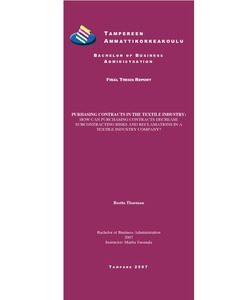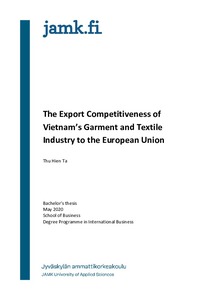Pakistani and Finnish textile industry and risk factors for Pakistani textile industry : Comparison of textile industries in countries, financial performance and survey report of risk factors for Pakistani textile industry
Zeeshan, Muhammad (2020)
Zeeshan, Muhammad
2020
All rights reserved. This publication is copyrighted. You may download, display and print it for Your own personal use. Commercial use is prohibited.
Julkaisun pysyvä osoite on
https://urn.fi/URN:NBN:fi:amk-2022112123279
https://urn.fi/URN:NBN:fi:amk-2022112123279
Tiivistelmä
The main aim of this thesis is to define the overall history and the present condition of textile industries of Pakistan and Finland, and what risk factors are affecting to Pakistani textile industry. Textile sector is playing a big role for the economic development of Pakistan, while after the fall down of the Soviet Union in the early ‘90s; the Finnish textile industry has been in a downfall.
The research found out that a great difference exists in the textile businesses in Pakistan and Finland. Textile industry in Pakistan is the biggest manufacturing industry. Textile sector is 8.5% of GDP in Pakistan. Finnish textile industry is more than 250 years before, in the 21st century; the prospective of the Finnish textile industry lies in high quality, product design, technically demanding products and elastic deliveries. In Finland the industry focuses mainly on product development and designing. The main difference between Pakistan and Finland in textile sector is labor cost and technological resources.
This report will show what types of risks having Pakistani textile industry nowadays and what are the solutions, to make this business more successful. Report is also covering a brief report of financial performance of a textile industry Nishat Textile Mills Ltd. Financial measurements will help to understand some of the recommendations given at the end of the thesis include the need for training employers and employees on business ethics and, coaching regarding this field. Conclusions were then drawn to sum up the entire thesis.
The research found out that a great difference exists in the textile businesses in Pakistan and Finland. Textile industry in Pakistan is the biggest manufacturing industry. Textile sector is 8.5% of GDP in Pakistan. Finnish textile industry is more than 250 years before, in the 21st century; the prospective of the Finnish textile industry lies in high quality, product design, technically demanding products and elastic deliveries. In Finland the industry focuses mainly on product development and designing. The main difference between Pakistan and Finland in textile sector is labor cost and technological resources.
This report will show what types of risks having Pakistani textile industry nowadays and what are the solutions, to make this business more successful. Report is also covering a brief report of financial performance of a textile industry Nishat Textile Mills Ltd. Financial measurements will help to understand some of the recommendations given at the end of the thesis include the need for training employers and employees on business ethics and, coaching regarding this field. Conclusions were then drawn to sum up the entire thesis.
Kokoelmat
Samankaltainen aineisto
Näytetään aineisto, joilla on samankaltaisia nimekkeitä, tekijöitä tai asiasanoja.
-
Purchasing contracts in the textile industry : how can purchasingcontracts decrease subcontracting risks and reclamations in a textile industry company?
Thurman, Reetta (Tampereen ammattikorkeakoulu, 2007) -
Application of Closed-Loop Textile-to-Textile Systems of SMEs in the Nordic Garment Industry
Anttonen, Roope (2021)It is well acknowledged that the textile industry is encountering a variety of global sustainability challenges. Whereas the environmental damage caused by the industry will affect its players' future competitive aspects ... -
The Export Competitiveness of Vietnam’s Garment and Textile Industry to the European Union
Ta, Thu Hien (2020)Vietnam, a country with an abundant amount of workforce for manufacturing sectors, as well as the complementary physical attributions, selected the Garment and Textile indus-try (G&T), more specifically, the exportations ...


